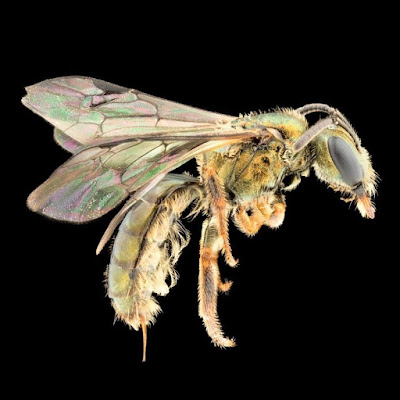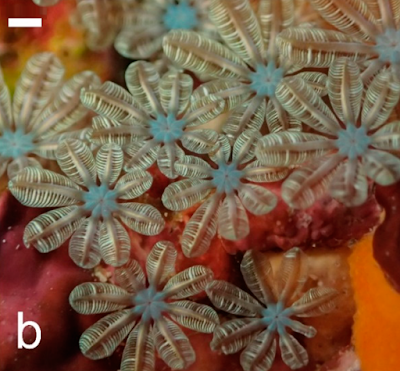[Most Recent Entries] [Calendar View]
Tuesday, September 24th, 2019
| Time | Event | ||
| 2:42p | [Entomology • 2019] Review of the Bee Genus Homalictus Cockerell (Hymenoptera: Halictidae) from Fiji with Description of Nine New Species
Abstract The genus Homalictus Cockerell has not been taxonomically reviewed in the Fijian archipelago for 40 years. Here we redescribe the four known species and describe nine new ones, bringing the number of endemic Homalictus in Fiji to 13 species. We provide identifications keys to all species. Most of the species diversity (11 species) have their distributions over 800 m asl (meters above sea level; highlands), and with only two species under 800 m asl (lowlands). We highlight the vulnerability of the highland-restricted species to a warming climate, and document the potential extinction of one highland species. The new species described here are H. atritergus sp. nov., H. concavus sp. nov., H. groomi sp. nov., H. kaicolo sp. nov., H. nadarivatu sp. nov., H. ostridorsum sp. nov., H. taveuni sp. nov. H. terminalis sp. nov. and H. tuiwawae sp. nov.. Keywords: Hymenoptera, DNA barcodes, Lasioglossum, Pacific Islands, taxonomy, Viti Levu Taxonomy: Family Halictidae Thomson, 1869 Subfamily Halictinae Thomson, 1869 Tribe Halictini Thomson, 1869 Genus Homalictus Cockerell, 1919 Homalictus achrostus Michener, 1979 Homalictus fijiensis (Perkins & Cheesman, 1928) Homalictus versifrons (Perkins & Cheesman, 1928) Homalictus atritergus sp. nov. Etymology. T1 of both males and females of H. atritergus are black. The name H. atritergus is derived from the Latin adjective atri meaning ‘dark’ (genitive case of ‘ater’) and the noun tergus meaning ‘back’ or ‘rear’. Homalictus concavus sp. nov. Etymology. The name concavus is Latin for ‘concave’ and refers to the concave posterior scutal margin in both the males and females of this species. Homalictus groomi sp. nov. Etymology. Homalictus groomi is named after Dr. Scott V. C. Groom who initiated recent studies of Fijian bees and provided the first understandings of their origins and phylogenetics. Homalictus kaicolo sp. nov. Etymology. The name H. kaicolo is a noun in apposition derived from the Fijian term “kai colo” (pronounced ky-thow-low) which means “from the hills”. H. kaicolo is named so because of its wider-distribution in the highland regions of Viti Levu, between 800 m asl and 1,100 m asl. Homalictus nadarivatu sp. nov. Etymology. The name H. nadarivatu refers to the region that this species was discovered in, Nadarivatu (pronounced Nan-dari-vah-two) on the Fijian island of Viti Levu. Homalictus ostridorsum sp. nov. Etymology. Both the males and females of this species have a purple scutum. The name is derived from the Latin ostrum meaning ‘purple’ and dorsus meaning ‘back’. Homalictus taveuni sp. nov. Etymology. The name H. taveuni refers to the island of Taveuni that this species appears to be restricted. Homalictus terminalis sp. nov. Etymology. Homalictus terminalis has only been found within 95 m of the maximum elevation available to it. The Latin noun terminalis means limit or boundary indicating the upper elevational and thermal limit that H. terminalis inhabits and could ultimately result in its extinction with global climate warming. Homalictus tuiwawae sp. nov. Etymology. Homalictus tuiwawae is named in recognition of Marika Tuiwawa, the herbarium curator at the Faculty of Science, Technology and Environment at the University of the South Pacific. Marika Tuiwawa has been a key facilitator for past and ongoing bee research in Fiji, contributing greatly to our ecological and behavioural studies, and the discovery of new species in Fiji. James B. Dorey, Michael P. Schwarz and Mark I. Stevens. 2019. Review of the Bee Genus Homalictus Cockerell (Hymenoptera: Halictidae) from Fiji with Description of Nine New Species. Zootaxa. 4674(1); 1–46. DOI: 10.11646/zootaxa.4674.1.1 Colorful New Bee Species Discovered in Fiji, but Extinction From Climate Change Feared - scitechdaily.com/colorful-new-bee-specie | ||
| 3:09p | [Botany • 2019] Begonia maguniana (Begoniaceae, sect. Oligandrae) • A New Species from New Guinea
Abstract The new species Begonia maguniana H.P.Wilson from New Guinea is described. It is endemic to the Central Range of New Guinea at altitudes of c.1700–2300 m and belongs to the IUCN category Least Concern. Keywords: Begonia, biodiversity, New Guinea, new species, taxonomy Begonia maguniana H.P.Wilson sp. nov. Etymology. Begonia maguniana is named after Thomas Magun (LAE Herbarium, Papua New Guinea), who, with Axel Poulsen, collected this species in Telefomin in April 2017. H. P. Wilson, O. Paul and M. Hughes. 2019. Begonia maguniana (Begoniaceae, Begonia sect. Oligandrae), A New Species from New Guinea. Edinburgh Journal of Botany. DOI: 10.1017/S0960428619000283 | ||
| 3:18p | [Cnidaria • 2019] Hadaka nudidomus • Zooxanthellate, Sclerite-Free, and Pseudopinnuled Octocoral (Anthozoa, Octocorallia) from Mesophotic Reefs of the Southern Ryukyus Islands
Abstract Shallow water coral reefs are the most diverse marine ecosystems, but there is an immense gap in knowledge when it comes to understanding the diversity of the vast majority of marine biota in these ecosystems. This is especially true when it comes to understudied small and cryptic coral reef taxa in understudied ecosystems, such as mesophotic coral reef ecosystems (MCEs). MCEs were reported in Japan almost fifty years ago, although only in recent years has there been an increase in research concerning the diversity of these reefs. In this study we describe the first stoloniferous octocoral from MCEs, Hadaka nudidomus gen. nov. et sp. nov., from Iriomote and Okinawa Islands in the southern Ryukyus Islands. The species is zooxanthellate; both specimens host Cladocopium LaJeunesse & H.J.Jeong, 2018 (formerly Symbiodinium ‘Clade C’) and were collected from depths of ~33 to 40 m. Additionally, H. nudidomus gen. nov. et sp. nov. is both sclerite-free and lacks free pinnules, and both of these characteristics are typically diagnostic for octocorals. The discovery and morphology of H. nudidomus gen. nov. et sp. nov. indicate that we still know very little about stoloniferous octocoral diversity in MCEs, their genetic relationships with shallower reef species, and octocoral–symbiont associations. Continued research on these subjects will improve our understanding of octocoral diversity in both shallow and deeper reefs. Keywords: Cladocopium; cryptofauna; marine biodiversity; mesophotic coral reef environments (MCEs); Octocorallia; stoloniferous octocorals; Symbiodiniaceae; taxonomy Class Anthozoa Subclass Octocorallia Ehrenberg, 1831 Order Alcyonacea Lamouroux, 1812 Family Clavulariidae Hickson, 1894 Genus Hadaka gen. nov. Type species: Hadaka nudidomus sp. nov. by original designation and monotype. Diagnosis: Colony with polyps connected through flattened ribbon-like stolons, which are loosely attached to a hard substrate. Polyps retract fully into the calyx, which is cylindrical to conical in shape, narrowing at the base and does not retract fully into the stolon. Tentacles have a wide rachis with a protruding ridge and pseudopinnules of different lengths arranged on either side, giving the polyps feather shaped tentacles. No sclerites. Zooxanthellate. Remarks: Hadaka gen. nov. et sp. nov. shows gross resemblance to Hanabira Lau, Stokvis, Imahara & Reimer, 2019 in having a similar polyp shape with feather or petal shaped tentacles and fused pinnules, which can still be distinguished by shallow furrows. Hadaka gen. nov. et sp. nov. differs from Hanabira in having no sclerites in any part of the colony and having a protruding ridge on the upper side of the tentacle. Genetically, Hadaka gen. nov. is well-supported and positioned in a different phylogenetic clade from Hanabira. The closest sister taxa of Hadaka gen. nov. is Acrossota Bourne, 1914, which is also sclerite-free, but morphologically very different; Acrossota lacks pinnules completely. Etymology: From the Japanese word hadaka (裸), meaning naked, bare, nude; denoting the absence of two characteristic features of octocorals, sclerites, and free pinnules. Gender: feminine. Hadaka nudidomus sp. nov. Distribution: Southwestern Japan, southern Ryukyus Islands, around northern Okinawa Island, and inside the bay of western Iriomote Island in the East China Sea. Specimens were collected from depths of ~33–40 m. Remarks: The polyps of paratype NSMT-Co 1682 were all used for DNA extraction and sclerite examination, as they were initially thought to be a Hanabira yukibana specimen; three fragments of rock with stolon remain. The holotype colony (NSMT-Co 1681) was attached to sponge tissue, but this epibiont is not obligate, as the paratype was attached to rock. Habitat: The holotype (NSMT-Co 1681) was found attached to sponge on a large piece of coral rubble (>15 cm) lying on a mixed small rubble/soft sediment bottom. The paratype (NSMT-Co 1682) was found on consolidated hard carbonate bottom. Both colonies were on the upward-facing side of the bottom. Etymology: From Latin nudus, meaning naked or bare, and domus, meaning home or house; denoting the ‘naked’ host habitat in which the zooxanthellae reside, as the species is sclerite-free. Yee Wah Lau and James Davis Reimer. 2019. Zooxanthellate, Sclerite-Free, and Pseudopinnuled Octocoral Hadaka nudidomus gen. nov. et sp. nov. (Anthozoa, Octocorallia) from Mesophotic Reefs of the Southern Ryukyus Islands. Diversity. 11(10), 176. DOI: 10.3390/d11100176 |
| << Previous Day |
2019/09/24 [Calendar] |
Next Day >> |













